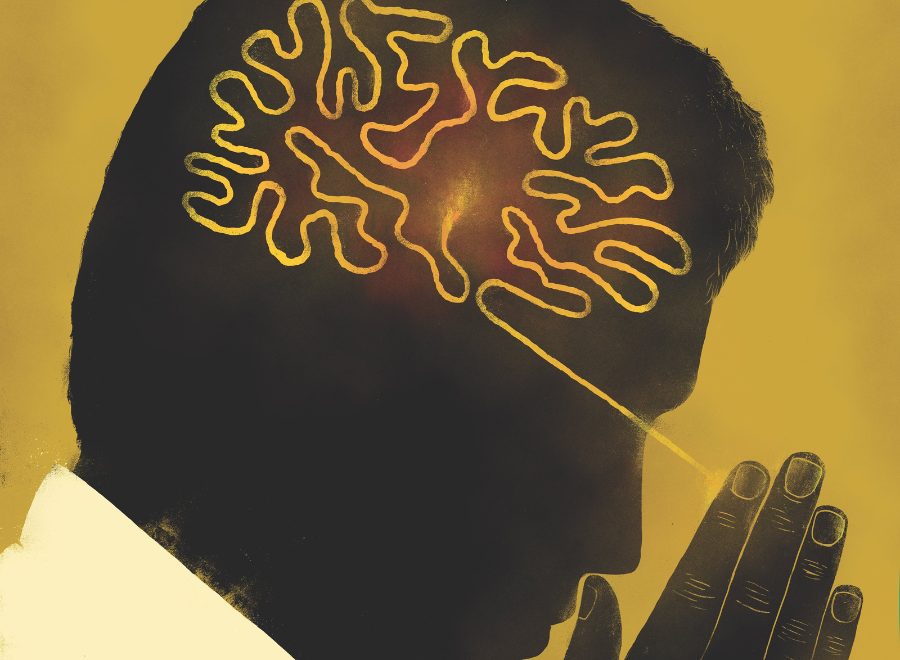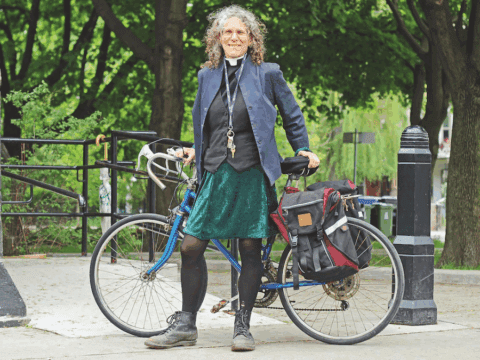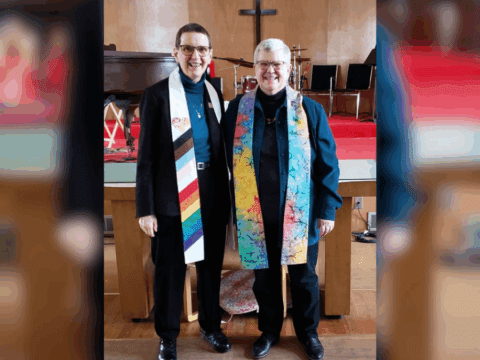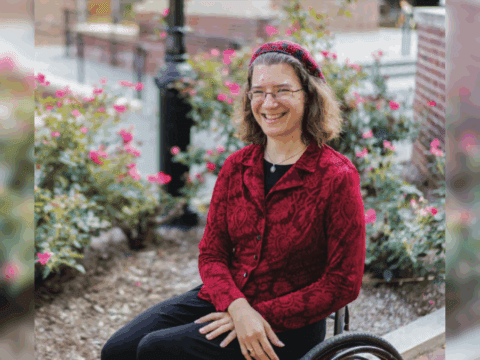Prayer is powerful. No surprise there. The spiritually inclined have been testifying to the power of prayer for millennia. But now science is proving it. For a little over a decade, a growing number of neurotheologians (researchers who study the brain science behind religious and spiritual experience) have brought prayer into the lab. The results are stunning.
Not only is prayer proving to be incredibly healthy — right up there with eating right and exercising — it is rewiring our brains. What’s more, the neuroscience behind prayer is reigniting old debates about nature or nurture, exploding dualistic body-versus-spirit theology and sparking controversy over the reality of consciousness.
Andrew Newberg has been studying the neurological effects of prayer and meditation since the late 1990s. The director of research at the Jefferson Myrna Brind Center of Integrative Medicine in Philadelphia, Newberg is the author of several books, including How God Changes Your Brain. His pioneering experiments involve inserting radioactive dye into the brains of both spiritual novices and high-achievers like Franciscan nuns, Buddhist monks and evangelical Christians when they’re hard at prayer.
“The thing that has always been so striking to me is just how rich and diverse spiritual experiences are for people, how they activate so many different parts of the brain,” he says. “There isn’t just one part of the brain that makes us religious or spiritual. If there is a spiritual part of ourselves, it’s our entire brain and how it works when we have these deep experiences, because it seems to be a complex pattern of activity in different directions.”
Newberg reports increased activity in the frontal lobes (the part of the brain that helps focus attention) and, depending on the kind of prayer, increased activity in the language, visualization, emotional and motor centres. The difference between prayer and other activities lies in the ignition.
“With religious activity, you seem to engage many other parts of the brain you typically don’t see with simply trying to solve a math problem or driving down the street,” Newberg says. “Prayer creates for the person fundamentally different experiences than any other experiences we have. The distinction comes with the pattern of activity and the intensity of activity.”
While prayer revs up certain parts of the brain, it shuts down others. Several studies show that at the height of prayer, the parietal lobes (the portion of the brain that normally takes our sensory information, orients us in the world and gives us a sense of ourselves) go dark. In other words, when people describe “getting lost” in prayer or “feeling at one with the universe,” that’s exactly what’s happening neurologically. The research has potentially wide consequences. Newberg wonders if losing ourselves in prayer may help us find compassion.
“The impact of prayer on violence is an area that hasn’t been studied. But if you get into an existential state where you feel connected to all of humanity, at one with all, then it almost by its very nature has to foster a sense of inclusion and connection,” he speculates.
There’s more good news. Various studies have demonstrated that prayer helps us manage anxiety and depression, boosts the immune system, enhances our capacity to absorb and maintain information, makes us more open to new ideas and increases our pain tolerance. It can even make us less prone to the effects of aging. The longer you meditate, the greater your gyrification (“folding” of the cortex, the part of the brain that helps us process information). These wrinkles are a thing of beauty: the more there are, the better the brain is at making decisions, governing emotions and forming memories.
But what qualifies as prayer? Does our brain expand if we mumble a prayer while washing the dishes, or do we have to sit cross-legged for hours to reap the physiological rewards?
Newberg says it’s complicated. “Not all types of prayer affect the brain in the same way, and these practices are dynamic processes in and of themselves. So let’s say you started out doing the rosary. Well, when you first start doing the rosary, after the first minute or two, your brain is doing something different than if you are doing it after a half hour, an hour or two hours. You can get to a deeper state, a more powerful state . . . even while doing that same exact process.”
No matter the form of prayer, sincerity counts. One study that compared the brain activity of atheists and religious people deep in meditation showed dramatically different activity in the frontal lobes. However, Newberg argues that by contemplating God, non-believers can achieve the same neural benefits as the faithful. “It doesn’t matter if you’re a Christian or a Jew, a Muslim or a Hindu, or an agnostic or an atheist,” he writes in How God Changes Your Brain, co-authored with Mark Waldman. You don’t have to be the Gretzky of prayer to get results.
Neuroscientist Richard Davidson, who teaches at the University of Wisconsin-Madison, wondered if ordinary people could achieve the same results as the spiritually elite. After just two months’ practice, amateurs had “a systematic change in both the brain as well as the immune system in more positive directions,” he told an NPR reporter. The brain is proving to be more flexible than once thought. “You can sculpt your brain just as you’d sculpt your muscles if you went to the gym. Our brains are continuously being sculpted, whether you like it or not, wittingly or unwittingly.
If prayer can be observed in the brain, can scientists flip the process — stimulating the brain to invoke a feeling of prayer? Canadian researcher Michael Persinger, who teaches at Laurentian University in Sudbury, Ont., made waves when he invented what a British tabloid first dubbed the “God Helmet.” The device fits over the head and stimulates the brain’s temporal lobes, generating weak, fluctuating magnetic fields similar in strength to those of a landline phone. Persinger says that 80 percent of people who test drove the helmet experienced a sense of presence, a sentient being in some form.
“How they interpreted it varies with their culture. Religious people would say it was God or a deceased member of the family. Atheists would say, ‘It’s in my brain, but I still feel it,’” he reports.
Persinger’s studies have come under fire, particularly from a group of Swedish researchers who say that his experiments are flawed and can’t be duplicated. “The Swedes couldn’t replicate it because they used the wrong kind of computer, they distorted the signal, and despite the fact that we pointed out their technical limitations, this became a really big political hot potato,” he says, adding that his research is a flashpoint in debates between atheists and religious stakeholders. “The truly religious people I’ve met — the priests, imams, Jesuits — they are curious. They say, ‘Let’s find out.’ They are open. But [other believers], if you challenge their belief system, they try to get rid of you,” he says.
Persinger isn’t the only neuroscientist on the frontier whose work challenges traditional notions of spirituality. Neurotheology as a discipline nips at the ankles of a broad spectrum of beliefs, including the traditional notion of free will, mind-matter dualism and the nature of consciousness.
Traditional theology solves the problem of an all-powerful, all-loving God’s decision not to end violence and suffering by chalking it up to free will — in short, God so loves us that God gives us the freedom to choose to destroy ourselves. But how much free choice do we really have when much of what we take in flies beneath our cognitive radar? In Strangers to Ourselves: Discovering the Adaptive Unconscious, for example, Timothy Wilson writes that the human mind registers roughly 11 million pieces of information per second, yet we can only be conscious of about 40.
What’s more, our choices may be predictable. In a 2008 study, scientists looking at brain scans were able to predict whether subjects would press a button with their left or right hand up to 10 seconds before the subject became aware of having made that choice. “How can I call a will ‘mine’ if I don’t even know when it occurred and what it has decided to do?” asks study co-author John-Dylan Haynes, a professor at the Bernstein Center for Computational Neuroscience in Berlin.
But before we jump to the conclusion that when it comes to prayer — or anything else — our brains “make us do it,” many scientists say otherwise. Mario Beauregard, a Canadian researcher with a PhD in neuroscience and the co-author of The Spiritual Brain: A Neuroscientist’s Case for the Existence of the Soul, is at the head of the pack, arguing that humans “aren’t biological machines controlled by physical processes in the body.” Beauregard cites neurotheological studies on the impact of prayer to bolster his argument, along with the placebo effect, evidence of consciousness during cardiac arrest and various studies related to near-death experience. “Our beliefs alter our brain. The mind and consciousness affect us on an atomic and subatomic level,” he says.
While Persinger says his work is attacked by the religious right, Beauregard claims mainstream thinking is controlled by secular humanists. “It’s an ideological battle. Young scientists are afraid to come out in support of the new science because they are afraid for their jobs and losing grants.” Last February, he launched an online petition called the “Manifesto for a Post-Materialist Science” urging academics to put their non-materialist world views on record. So far, of the 61 academics who have signed, most hold professor emeritus positions and, according to Beauregard, have less at stake in the debate. “It will change in 20 or 30 years anyway. We are in the midst of a scientific revolution. There is no stopping it.”
There is no doubt that prayer has a powerfully positive effect on the brain. How it works remains a mystery; why it works, even more so. While the studies raise a broad range of philosophical issues, at the heart of the debate is the very nature of God. Newberg’s conclusion is cautious: “Maybe it’s not the brain that’s creating the spiritual experience, but it may be the way God interacts with us. There really is no way to tell from a brain scan what the reality of the prayer experience is.”
***
This story first appeared in The United Church Observer’s January 2015 issue with the title “Unravelling the mysteries of prayer.”
















Where is this article published? I’d like a copy to give to a speaker on prayer. 704-965-4720
Hi Lowell, it is from an archival issue of our magazine and not easily retrievable in print form. Your best bet might just be to print this page off and send it to your speaker!
Best,
Emma